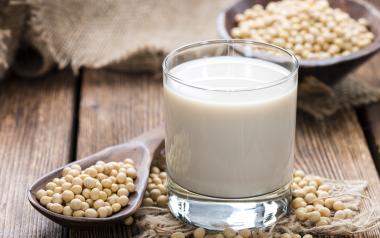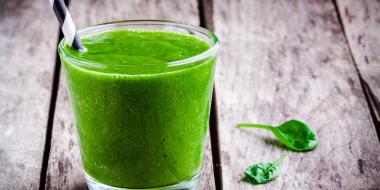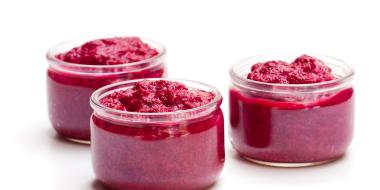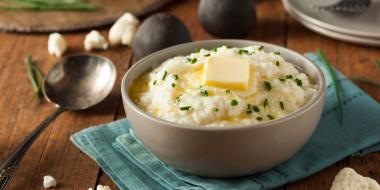Between six and nine months of age, babies typically become ready for the introduction of new foods and traditionally this has included cow's milk. For many reasons—a vegan lifestyle, dairy sensitivities and allergies, for example—giving your baby milk may not be an option. Parents want to know how to meet some of the developing nutritional needs of babies that cow's milk can provide by choosing dairy alternatives and foods that are high in the same nutrients. Happily, there are many choices available that fit the bill!
Measuring up the alternatives to cow's milk
As seen below, the issue with most non-animal milk alternatives is the much lower caloric, protein, and fat content, but they are comparable to cow’s milk with regards to vitamin D and calcium. The protein in goat’s milk can be more easily digested and better tolerated and it is a commonly recommended alternative for those who have sensitivities to cow’s milk. If goat’s milk will be your child’s main milk source, make sure that you are buying a fortified version with comparable calcium and vitamin D content. If cow or goat's milk isn’t going to be on your child’s menu due to allergy, vegan lifestyle, or for other reasons, it is advisable to seek the services of a dietitian or naturopathic doctor who can help you ensure that your child’s diet has sufficient calories, protein, and fat.
|
Milk (1 cup) |
Calories (kcal) | Protein (g) | Fat (g) |
Calcium (% daily value) |
Vitamin D (% daily value) |
|---|---|---|---|---|---|
|
Cow's Milk (3.25%) |
160 | 9 | 8 | 30% | 45% |
| Goat | 168 | 9 | 10 | 33% | 31% |
| Soy | 100 | 7 | 4 | 35% | 25% |
| Almond | 50 | 1 | 2.5 | 30% | 25% |
| Rice | 120 | 1 | 2.5 | 30% | 25% |
| Hemp | 100 | 4 | 6 | 30% | 25% |
*each alternative is the fortified, original flavor version
Other foods to offer your child when you're dairy-free
The fats, calcium, and vitamin D found in dairy are also contained in other foods and offering these can help to expand your child's diet while still getting those great nutrients.
Calcium
- Cooked spinach (from frozen) ½ cup = 154 mg
- Canned salmon (with bones) 2.5 oz = 179-212 mg
- Tofu (prepared with calcium sulphate) ¾ cup = 302-525 mg
- Tahini (sesame seed butter) 2 tbsp = 130 mg
- Beans (white or navy, canned or cooked) ¾ cup = 93-141 mg
Vitamin D
- Egg yolk (cooked) 2 large = 57-88 IU
- Salmon (sockeye/red, canned, cooked) 2.5 oz = 530-699 IU
- Salmon (Atlantic, cooked) 2.5 oz = 181-246 IU
- Trout (cooked) 2.5 oz = 150-210 IU
- Talk to your naturopathic or medical doctor about appropriate supplementation
Fat and Protein
- Avocado
- Eggs
- Nut butters (talk to your ND, dietitian or MD about safe introduction)
- Beans and Chickpeas
- Chia seeds + coconut milk (try in the form of chia seed pudding)
- Yogurt (full-fat)
Babies' and toddlers' daily nutritional needs
Depending on your child's age and weight, their calorie and nutrient needs are different. These recommended amounts are expressed as Recommended Dietary Allowances (RDA), the average daily amount that is considered sufficient to meet the requirement of nearly all (97-98%) healthy individuals in a particular life stage and gender group. Values are based on a reference weight (7-12 months: 20 lbs, 1-3 years: 27 lbs). Your child’s individual needs may differ and can be discussed with a naturopathic doctor, dietitian or medical doctor.
| Age | Calories (kcal) | Protein (g) | Total Fat (g) | Calcium (mg) | Vitamin D (IU) |
|---|---|---|---|---|---|
| 7-12 Months | See below | 11 g | 30% | 260 | 400 |
| 1-3 Years | See below | 13 g | 30-40% | 700 | 600 |
The requirement for the number of grams of fat per day in a child’s diet varies. Total fat should make up a certain percentage of daily calories. The American Heart Association dietary guidelines recommend that a one-year old child have 900 kcal/day and a two-to-three-year-old consume 1000 kcal/day. Health Canada uses an equation to calculate recommended caloric intake that takes your child’s weight into account.
Calorie requirements of infants and young children
Estimated Energy Requirement (kcal/day) = Total Energy Expenditure + Energy Deposition
-
0-3 months
-
EER = (89 x weight [kg] -100) + 175
-
4-6 months
-
EER = (89 x weight [kg] -100) + 56
-
7-12 months
-
EER = (89 x weight [kg] -100) + 22
-
13-35 months
-
EER = (89 x weight [kg] -100) + 20
*Originally published November 11, 2016
Consolini DM. Nutrition in Infants. Merck Manual Professional Edition. Nov 2013.
Dietitians of Canada. Food Sources of Calcium. 2016.
Dietitians of Canada. Food Sources of Vitamin D. 2016.
Dietitians of Canada. Understanding non-dairy alternatives. 2016.
Fleischer DM, Spergel JM, Assa’ad AH, Pongracic JA.Primary prevention of allergic disease through nutritional interventions.
Health Canada. Dietary Reference Intakes Tables. 2010 Nov 29.
Health Canada. Guideline: Nutrition for Health Term Infants: Recommendations from 6-24 months.2015 Jan 19.
USDA. Milk, Goat, Fluid, with added Vitamin D. USDA National Nutrient Database for Standard Reference. 2016.






